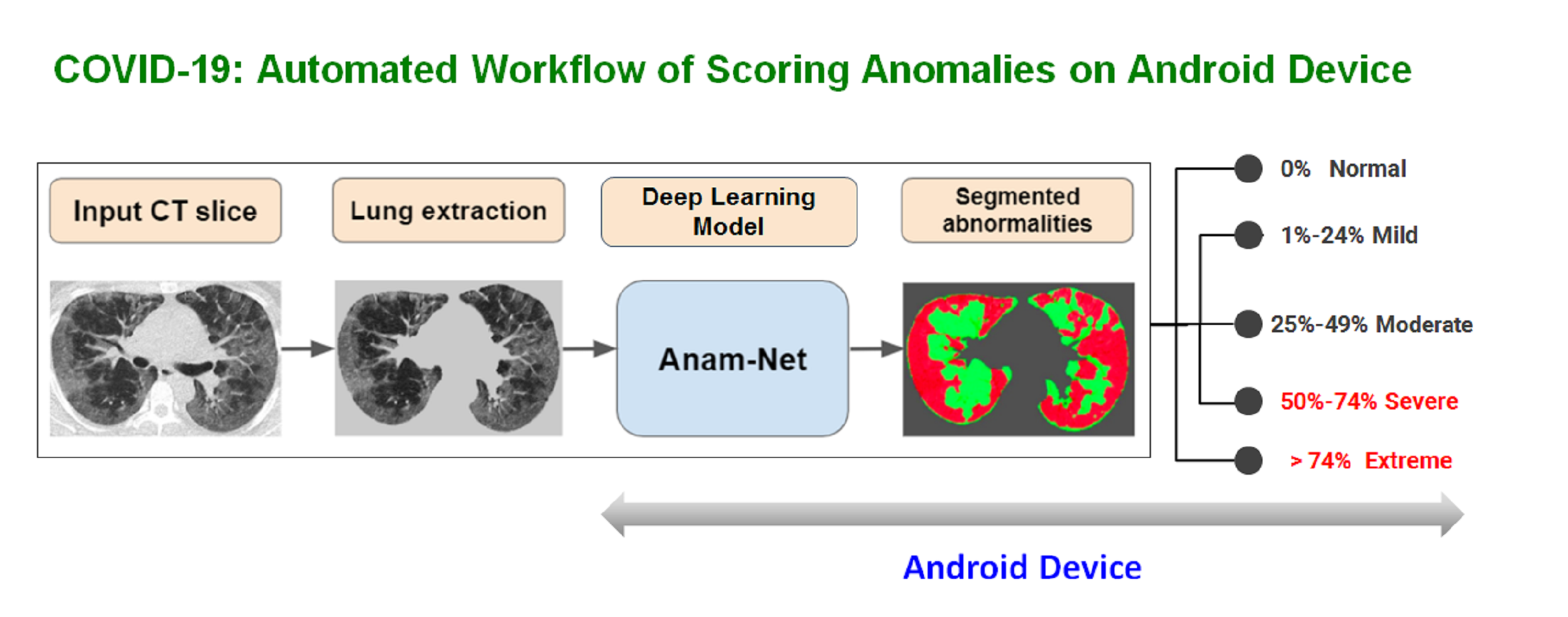MiniCOVIDNET: Lung Ultrasound
based Point of Care Detection of COVID19
Navchetan Awasthi, Aveen
Dayal, Linga
R.
Cenkeramaddi,
and Phaneendra K.
Yalavarthy, "Mini-COVIDNet
: Efficient
Light Weight
Deep Neural
Network for
Ultrasound
based
Point-of-Care
Detection of
COVID-19," IEEE Transactions on Ultrasonics, Ferroelectrics, and
Frequency
Control 68(6),
2023-2037
(2021). [doi: 10.1109/TUFFC.2021.3068190]. Coverpage article

Acknowledgements:
- Indian Institute of Science, Bangalore
- University of Agder, Norway
This work in part was supported by the WIPRO-GE Collaborative Laboratory on Artificial Intelligence in Healthcare and Medical Imaging and Indo-Norwegian collaboration in Autonomous Cyber-Physical Systems (INCAPS) project: 287918 of International Partnerships for Excellent Education, Research and Innovation (INTPART) program from the Research Council of Norway.
Disclaimer:
The software and applications developed are not intended, nor should they be construed, as claims that this can be used to diagnose, treat, mitigate, cure, prevent or otherwise be used for any disease or medical condition. The software/application has not been clinically proven or evaluated.
Media Coverage
- IISc Press Release: https://iisc.ac.in/events/mini-covidnet-mobile-friendly-point-of-care-detection-of-covid19-using-ultrasound-images/
- Bangalore Mirror: https://bangaloremirror.indiatimes.com/bangalore/others/isolation-or-icu-indian-institute-of-sciences-test-can-tell/articleshow/81657649.cms
- Deccan
Herald: https://www.deccanherald.com/state/researchers-back-ultrasound-lung-scans-to-tell-severity-of-covid-infection-968512.html
AnamNET: Chest Computed Tomography based COVID-19 Scoring

Covseg
Android Application:

Paluru N, Dayal A, Jenssen HB, Sakinis T, Cenkeramaddi LR, Prakash J, Yalavarthy PK. Anam-Net: Anamorphic Depth Embedding-Based Lightweight CNN for Segmentation of Anomalies in COVID-19 Chest CT Images. IEEE Trans Neural Netw Learn Syst. (Fast Track: COVID-19 Focused Papers) 32(3), 932-946 (2021). [doi: 10.1109/TNNLS.2021.3054746]
https://ieeexplore.ieee.org/document/9349153/
Project Code Repository: https://github.com/NaveenPaluru/Segmentation-COVID-19
Acknowledgements:
- Indian Institute of Science, Bangalore
- University of Agder, Norway
- Oslo University Hospital, Norway
This work in part was supported by the WIPRO GE-CDS Collaborative Laboratory on Artificial Intelligence in Healthcare and Medical Imaging as well as Indo-Norwegian Collaboration in Autonomous Cyber-Physical Systems (INCAPS), INTPART Programme, Research Council of Norway.
Disclaimer:
The software and applications developed are not intended, nor should they be construed, as claims that this can be used to diagnose, treat, mitigate, cure, prevent or otherwise be used for any disease or medical condition. The software/application has not been clinically proven or evaluated.
Media Coverage:
- IISc Press Release: https://www.iisc.ac.in/events/ai-based-software-tool-for-automated-diagnosis-of-covid-19-lung-infection/
- Business Standard: https://www.business-standard.com/article/current-affairs/ai-based-software-tool-for-automated-diagnosis-of-covid-19-lung-infection-121021701120_1.html
- Business Line - The Hindu: https://www.thehindubusinessline.com/news/iisc-researchers-develop-ai-based-software-tool-for-diagnosis-of-covid-19-lung-infection/article33862370.ece
- Deccan Herald: https://www.deccanherald.com/science-and-environment/this-ai-based-software-tool-can-diagnose-covid-19-lung-infection-952321.html
- The Morung Express: https://morungexpress.com/and-now-an-ai-based-software-tool-for-automated-diagnosis-of-covid-19-lung-infection
- Eenadu (Telugu News Paper): https://m.eenadu.net/apstories/mainnews/general/2504/121035598
- News8plus: https://news8plus.com/ai-based-software-tool-for-automated-diagnosis-of-covid-19-lung-infection/
- Indian Express: https://www.newindianexpress.com/states/karnataka/2021/feb/18/iiscs-anamnet-reveals-severity-of-lung-infection-in-covid-19-patients-2265436.amp
- Times of India: https://timesofindia.indiatimes.com/city/bengaluru/software-tool-to-diagnose-covid-19-lung-infection/articleshow/81082518.cms